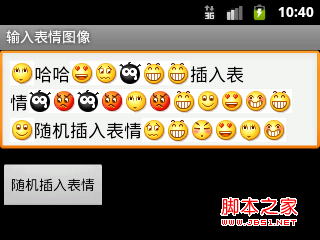編輯:Android開發實例
上次介紹了使用GridView實現表格,這次就說說如何用ListView實現自適應的表格。GridView比ListView更容易實現自適應的表格,但是GridView每個格單元的大小固定,而ListView實現的表格可以自定義每個格單元的大小,但因此實現自適應表格也會復雜些(格單元大小不一)。另外,GridView實現的表格可以定位在具體某個格單元,而ListView實現的表格則只能定位在表格行。因此還是那句老話:根據具體的使用環境而選擇GridView 或者 ListView實現表格。
先貼出本文程序運行的效果圖:
本文實現的ListView表格,可以每個格單元大小不一,文本(TextView)或圖片(ImageView)做格單元的數據,不需要預先定義XML實現樣式(自適應的根本目標)。由於ListView置於HorizontalScrollView中,因此對於列比較多/列數據比較長的數據表也能很好地適應其寬度。
main.xml源碼如下:
- <?xml version="1.0" encoding="utf-8"?>
- <LinearLayout xmlns:android="http://schemas.android.com/apk/res/android"
- android:orientation="vertical" android:layout_width="fill_parent"
- android:layout_height="fill_parent">
- <HorizontalScrollView android:id="@+id/HorizontalScrollView01"
- android:layout_height="fill_parent" android:layout_width="fill_parent">
- <ListView android:id="@+id/ListView01" android:layout_height="wrap_content"
- android:layout_width="wrap_content"></ListView>
- </HorizontalScrollView>
- </LinearLayout>
主類testMyListView.java的源碼如下:
- package com.testMyListView;
- import java.util.ArrayList;
- import com.testMyListView.TableAdapter.TableCell;
- import com.testMyListView.TableAdapter.TableRow;
- import android.app.Activity;
- import android.os.Bundle;
- import android.view.View;
- import android.widget.AdapterView;
- import android.widget.ListView;
- import android.widget.LinearLayout.LayoutParams;
- import android.widget.Toast;
- /**
- * @author hellogv
- */
- public class testMyListView extends Activity {
- /** Called when the activity is first created. */
- ListView lv;
- @Override
- public void onCreate(Bundle savedInstanceState) {
- super.onCreate(savedInstanceState);
- setContentView(R.layout.main);
- this.setTitle("ListView自適應實現表格---hellogv");
- lv = (ListView) this.findViewById(R.id.ListView01);
- ArrayList<TableRow> table = new ArrayList<TableRow>();
- TableCell[] titles = new TableCell[5];// 每行5個單元
- int width = this.getWindowManager().getDefaultDisplay().getWidth()/titles.length;
- // 定義標題
- for (int i = 0; i < titles.length; i++) {
- titles[i] = new TableCell("標題" + String.valueOf(i),
- width + 8 * i,
- LayoutParams.FILL_PARENT,
- TableCell.STRING);
- }
- table.add(new TableRow(titles));
- // 每行的數據
- TableCell[] cells = new TableCell[5];// 每行5個單元
- for (int i = 0; i < cells.length - 1; i++) {
- cells[i] = new TableCell("No." + String.valueOf(i),
- titles[i].width,
- LayoutParams.FILL_PARENT,
- TableCell.STRING);
- }
- cells[cells.length - 1] = new TableCell(R.drawable.icon,
- titles[cells.length - 1].width,
- LayoutParams.WRAP_CONTENT,
- TableCell.IMAGE);
- // 把表格的行添加到表格
- for (int i = 0; i < 12; i++)
- table.add(new TableRow(cells));
- TableAdapter tableAdapter = new TableAdapter(this, table);
- lv.setAdapter(tableAdapter);
- lv.setOnItemClickListener(new ItemClickEvent());
- }
- class ItemClickEvent implements AdapterView.OnItemClickListener {
- @Override
- public void onItemClick(AdapterView<?> arg0, View arg1, int arg2,
- long arg3) {
- Toast.makeText(testMyListView.this, "選中第"+String.valueOf(arg2)+"行", 500).show();
- }
- }
- }
ListView自適應實現Table的類TableAdapter.java代碼如下:
PS:TableCell是格單元的類,TableRow是表格行的類,TableRowView是實現表格行的組件。實現步驟:TableCell --> TableRow(TableRowView)-->ListView
- package com.testMyListView;
- import java.util.List;
- import android.content.Context;
- import android.graphics.Color;
- import android.view.Gravity;
- import android.view.View;
- import android.view.ViewGroup;
- import android.widget.BaseAdapter;
- import android.widget.ImageView;
- import android.widget.LinearLayout;
- import android.widget.TextView;
- public class TableAdapter extends BaseAdapter {
- private Context context;
- private List<TableRow> table;
- public TableAdapter(Context context, List<TableRow> table) {
- this.context = context;
- this.table = table;
- }
- @Override
- public int getCount() {
- return table.size();
- }
- @Override
- public long getItemId(int position) {
- return position;
- }
- public TableRow getItem(int position) {
- return table.get(position);
- }
- public View getView(int position, View convertView, ViewGroup parent) {
- TableRow tableRow = table.get(position);
- return new TableRowView(this.context, tableRow);
- }
- /**
- * TableRowView 實現表格行的樣式
- * @author hellogv
- */
- class TableRowView extends LinearLayout {
- public TableRowView(Context context, TableRow tableRow) {
- super(context);
- this.setOrientation(LinearLayout.HORIZONTAL);
- for (int i = 0; i < tableRow.getSize(); i++) {//逐個格單元添加到行
- TableCell tableCell = tableRow.getCellValue(i);
- LinearLayout.LayoutParams layoutParams = new LinearLayout.LayoutParams(
- tableCell.width, tableCell.height);//按照格單元指定的大小設置空間
- layoutParams.setMargins(0, 0, 1, 1);//預留空隙制造邊框
- if (tableCell.type == TableCell.STRING) {//如果格單元是文本內容
- TextView textCell = new TextView(context);
- textCell.setLines(1);
- textCell.setGravity(Gravity.CENTER);
- textCell.setBackgroundColor(Color.BLACK);//背景黑色
- textCell.setText(String.valueOf(tableCell.value));
- addView(textCell, layoutParams);
- } else if (tableCell.type == TableCell.IMAGE) {//如果格單元是圖像內容
- ImageView imgCell = new ImageView(context);
- imgCell.setBackgroundColor(Color.BLACK);//背景黑色
- imgCell.setImageResource((Integer) tableCell.value);
- addView(imgCell, layoutParams);
- }
- }
- this.setBackgroundColor(Color.WHITE);//背景白色,利用空隙來實現邊框
- }
- }
- /**
- * TableRow 實現表格的行
- * @author hellogv
- */
- static public class TableRow {
- private TableCell[] cell;
- public TableRow(TableCell[] cell) {
- this.cell = cell;
- }
- public int getSize() {
- return cell.length;
- }
- public TableCell getCellValue(int index) {
- if (index >= cell.length)
- return null;
- return cell[index];
- }
- }
- /**
- * TableCell 實現表格的格單元
- * @author hellogv
- */
- static public class TableCell {
- static public final int STRING = 0;
- static public final int IMAGE = 1;
- public Object value;
- public int width;
- public int height;
- private int type;
- public TableCell(Object value, int width, int height, int type) {
- this.value = value;
- this.width = width;
- this.height = height;
- this.type = type;
- }
- }
- }
 Android本地化
Android本地化
Android應用程序可以在許多不同地區的許多設備上運行。為了使應用程序更具交互性,應用程序應該處理以適合應用程序將要使用的語言環境方面的文字,數字,文件等。在本章中,我
 Android個人理財工具實例之五:顯示賬單明細 上
Android個人理財工具實例之五:顯示賬單明細 上
前面我們已經將每個月的收支明細存入到SQLite的數據表中,本文將實現從SQL
 Android開發技巧之像QQ一樣輸入文字和表情圖像
Android開發技巧之像QQ一樣輸入文字和表情圖像
EditText和TextView一樣,也可以進行圖文混排。所不同的是,TextView只用於顯示圖文混排效果,而EditText不僅可顯示,也可混合輸入文字和圖
 Android加載Spinner
Android加載Spinner
可以顯示在的Android任務,通過加載進度條的進展。進度條有兩種形狀。加載欄和加載微調(spinner)。在本章中,我們將討論微調(spinner)。Spinner 用